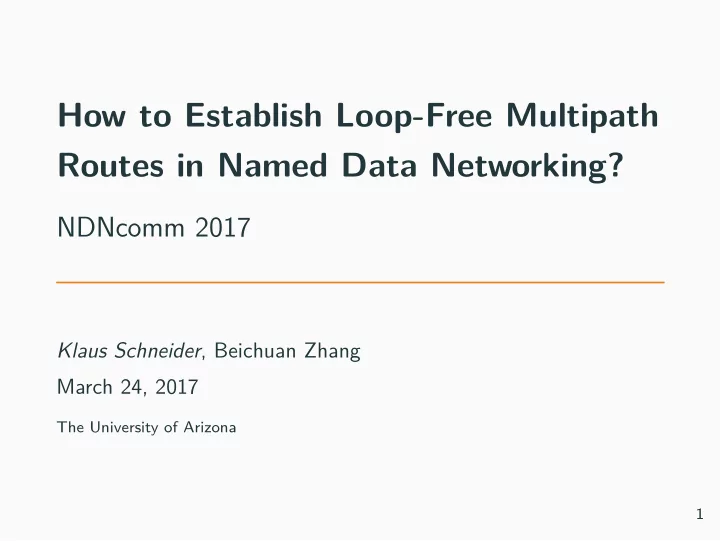

How to Establish Loop-Free Multipath Routes in Named Data Networking? NDNcomm 2017 Klaus Schneider , Beichuan Zhang March 24, 2017 The University of Arizona 1
Routing and Forwarding in IP Networks No Loop Detection on Forwarding Plane • Very high cost (packets loop through same routers until TTL runs out) ⇒ Routing has to be perfectly loop-free 2
Routing and Forwarding in IP Networks No Loop Detection on Forwarding Plane • Very high cost (packets loop through same routers until TTL runs out) ⇒ Routing has to be perfectly loop-free 2
Routing and Forwarding in IP Networks No Loop Detection on Forwarding Plane • Very high cost (packets loop through same routers until TTL runs out) ⇒ Routing has to be perfectly loop-free NDN: Detect & handle loops via nonce! 2
Traffic Splitting Great benefits of using multiple paths at the same time! • Load Balancing • Gradual shifting of traffic during congestion [1, 2] • Exploiting differences in cost and performance of paths (WiFi vs. LTE) [3] 3
Traffic Splitting Great benefits of using multiple paths at the same time! • Load Balancing • Gradual shifting of traffic during congestion [1, 2] • Exploiting differences in cost and performance of paths (WiFi vs. LTE) [3] Traffic Splitting requires Loop-Freeness and Path Choice 3
NLSR: High Path Choice, but many Loops 4
Loop-Free Routing: Limited Path Choice 5
Incoming Interface-Exclusion: Higher Path Choice 6
How To Achieve That? Via Routing? Too complex! 1. Trad: Undirected graph ⇒ Directed Acyclic Graph (DAG) 2. Now: ⇒ Directed graph without cycles longer than one hop! 7
How To Achieve That? Via Routing? Too complex! 1. Trad: Undirected graph ⇒ Directed Acyclic Graph (DAG) 2. Now: ⇒ Directed graph without cycles longer than one hop! Solution: 1. Almost Loop-free Routing (ALR) 2. On-demand Loop Removal at forwarding layer 7
Almost Loop-Free Routing Give each nexthop in FIB a Type: { Downward , Upward , Disabled } . 1. Fill FIB with Downward Nexthops 2. If prefix still has only one nexthop: • Go through all disabled nexthops: • If NH passes Heuristic Loop Checks: Add as Uphill; break; 8
Almost Loop-Free Routing Give each nexthop in FIB a Type: { Downward , Upward , Disabled } . 1. Fill FIB with Downward Nexthops 2. If prefix still has only one nexthop: • Go through all disabled nexthops: • If NH passes Heuristic Loop Checks: Add as Uphill; break; ⇒ Much more nodes with at least 2 nexthops , and low looping chance. Forwarding loop: Uphill Nexthop Removal (UNR) 8
Example of Loop-Freeness Heuristic 9
Example of Loop-Freeness Heuristic 9
Example of Loop-Freeness Heuristic 9
Example of Loop-Freeness Heuristic 9
Evaluation Results of 8 other routing protocols in 9 topologies: • ALR: Low computational complexity, similar to NLSR. • UNR: Very low forwarding complexity (only 0.4% to 1.6% of FIB entries need to be changed) Together: Completely loop-free network with higher path choice than loop-free routing for all tested topologies. 10
Summary How to Establish Loop-Free Multipath Routes in NDN? • Loop-free routing vs. Loop handling at Forw. Layer 11
Summary How to Establish Loop-Free Multipath Routes in NDN? • Loop-free routing vs. Loop handling at Forw. Layer Traffic Splitting needs Loop-freeness and high Path Choice • Loop-free routing provides former, but not latter. • Current NDN routing vice versa. ⇒ Achieving both by combining Almost-Loopfree Routing with Loop-removal at the forwarding layer. 11
Summary How to Establish Loop-Free Multipath Routes in NDN? • Loop-free routing vs. Loop handling at Forw. Layer Traffic Splitting needs Loop-freeness and high Path Choice • Loop-free routing provides former, but not latter. • Current NDN routing vice versa. ⇒ Achieving both by combining Almost-Loopfree Routing with Loop-removal at the forwarding layer. Future Work: • Tech Report coming soon! 11
The End Thank you for your attention! Questions? Klaus Schneider klaus@cs.arizona.edu 12
References I [1] Giovanna Carofiglio, Massimo Gallo, Luca Muscariello, Michele Papalini, and Sen Wang. Optimal multipath congestion control and request forwarding in information-centric networks. In ICNP , 2013. [2] Klaus Schneider, Cheng Yi, Beichuan Zhang, and Lixia Zhang. A practical congestion control scheme for named data networking. In Proceedings of ICN 2016 , pages 21–30. ACM, 2016. [3] Klaus M Schneider and Udo R Krieger. Beyond network selection: Exploiting access network heterogeneity with named data networking. In Proceedings of the 2nd International Conference on Information-Centric Networking , pages 137–146. ACM, 2015. 13
Recommend
More recommend